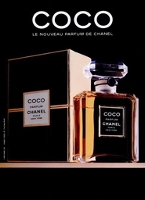Chanel Coco ~ fragrance review :: Now Smell This
Most of us have fragrance milestones: the first perfume we bought with our own money, our first “serious” perfume, and maybe our first signature scent, back before perfume mania sank the whole signature scent possibility. My first signature scent was Chanel Coco. Now, a couple of decades and hundreds of perfumes separate me from my Coco days. When I stopped by Nordstrom last week to ask for a sample of the Eau de Parfum, I didn’t hold out much hope I’d still like it. After all, I’ve loved and left my share of 1980s blockbusters.
Silly me. It turns out all those sample vials of scent from drugstores to niche perfumeries I devoured over the years only led me to appreciate Coco’s artistry more. Coco is warm, elegant, beautifully blended, and easy. No, it won’t shock or challenge. There’s nothing funky or bizarre or tough about it. But just as a dinner of perfectly roasted chicken, potatoes, sautéed chard, and glass of Pinot Noir by the fire won’t rock the world, it satisfies far more often than the sous vide-cooked special from the latest darling chef.
When Jacques Polge created Coco in 1984, he seems to have aimed to marry Chanel’s signature elegance to the trend for mega-Oriental perfumes kicked off by Yves Saint Laurent Opium. In Perfume Legends, Michael Edwards quotes Polge: “Coco became my interpretation of an Orient which begins and ends in Venice. Shalimar might take you to India, Opium to Marrakech, but with Coco, you would definitely stop at Venice.”1
Edwards lists Coco’s top notes as jasmine, peach, frangipani, mimosa, and orange blossom; its heart as cascarilla, orange blossom, rose, clove buds, and angelica; and its base as labdanum, sandalwood, tonka bean, leather, and opopanax. (Cascarilla is a shrub native to the West Indies with bark used to flavor liqueurs.)
To me, Coco takes the aldehydic top from the classic Chanels, then sweetens and fattens it up with a kick of orange. Chanel No. 5’s rose and jasmine heart is there, too, but veiled with a pinch of clove and cinnamon and blended with a toned-down version of the sweet and almost chewy resin at the core of Opium, Estée Lauder Cinnabar, and Dana Tabu. The dry down is warm, woody, and quietly resinous, with the barely discernible intimacy of patchouli rounding it out.
The whole composition feels like a solid mahogany table rubbed with orange oil and topped with a vase of fresh flowers and a hot cup of milky chai. Coco is big and should be applied sparingly, but it’s not the nostril scorcher some of the other 1980s fragrances, such as Christian Dior Poison and Giorgio, can be. Maybe it’s Coco’s name and packaging, but smelling it I think of charmeuse nightgowns, the insides of worn leather boots, 1940s sofas upholstered chocolate brown velvet, and brown lacquered fingernails so dark you mistake them for black. Coco, you old friend, welcome back.

Chanel Coco comes in a wide range of products, including Eau de Toilette, Eau de Parfum and Parfum. Matching body products are also available.
1. p. 207.






